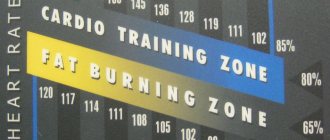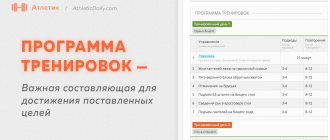Hiit training – what is it?
Hiit or HIIT training stands for high-intensity interval training. This technique is based on the sequence of performing more intense short workouts and less difficult periods.
An example of a HIIT workout: within a quarter of an hour, perform a combination that consists of sprints for 15 seconds, fast walking for 10-15 minutes.
There are two options for HIIT workouts: cardio or aerobic training and strength or anaerobic training.
Basic principles of Hiit training
The basic training program includes 5-15 programs. You need to start your workout with a warm-up and end with a cool-down.
The basic principles of HIIT include:
- the possible load is calculated based on the maximum heart rate. Maximum possible heart rate = 207- (07 * age). Based on your own feelings, it is possible to determine your heart rate in the easy and difficult periods, but it is better for a trainer to do this;
- for those who are just starting exercises, the ratio of heavy to moderate load is 1:3. Then, over time, the duration of the severe phase increases and the recovery time decreases;
- Before training, you should not eat foods containing L-carnitine (coffee, chocolate, fat burners). They increase the number of heart contractions and increase blood pressure, which can negatively affect health;
- during training, it is forbidden to drink sports drinks that contain fast carbohydrates;
- after class it is better to take a shower than to go to the sauna or bathhouse;
- Intense exercise is contraindicated on a low-carbohydrate diet.
Advantages and disadvantages
The main advantages of Hiit training are:
- Less time is spent on classes. According to research, a four-minute interval of HIIT is 10% more effective than regular running. In 16 min. training, you can get better results than if you run 3 times longer.
- Expend more calories. HIIT workouts burn 6 to 15% more calories than regular standard exercise. One part of the calories is consumed during exercise, and the other part is consumed during the process of excess oxygen consumption after exercise. Since a HIIT workout is intense, the body has to work hard to recover afterward. This requires additional energy expenditure, and therefore calories are burned for several hours after exercise.
- Sports achievements are getting better. These workouts are used to increase speed, agility, and strength.
- Availability. There are special training programs for home use. HIIT workouts do not require any additional special equipment.
Among the disadvantages of HIIT training are:
- It requires full dedication of the body to the point of complete exhaustion. Not everyone can withstand such intense stress. Many people are not ready to give 100% to lose a few kilograms.
- There is some danger. Excessive exercise for a beginner can cause a disease associated with the destruction of skeletal muscles. To avoid this, the load should be increased gradually. Also, with intense loads, the risk of injury increases.
- The body needs more time to recover. The minimum recovery time is 24 hours between workouts.
- Possibility of hormonal imbalances. When exercising with maximum impact, the production of a number of hormones increases: testosterone, endorphin, cortisol and others. Intense stress is stress for the body, and when other stressful situations are added to this (emotional stress, stress in the family), there is a risk of malfunction of the adrenal glands, which leads to loss of strength, sleep disturbance and other unpleasant consequences.
How to create a training program?
As with any fitness activity, high-intensity training programs are easily varied and depend on the needs of the athlete. Trainers use exercises that develop the maximum number of muscle groups. The training program also includes simple and long-familiar exercises - squats, lunges, push-ups, crunches, and the like.
We offer you one of the HIIT training schemes, designed for eight weeks (each of the four levels lasts two weeks).
- Stage 1 - the workout lasts about 15 minutes, the ratio of activity and rest is 1: 4
- Stage 2 - train for approximately 17 minutes, rest time is reduced by 2 times, the ratio is now 1: 2.
- Stage 3 - training time increases to 18.5 minutes, the duration of exercise and rest are equal to each other.
- Stage 4 is for high-intensity training professionals. The lesson lasts about 20 minutes, there is now twice as much activity as rest.
Before starting a HIIT workout (especially if you want to do it on your own), talk to your doctor and trainer. The first will determine your level of development, health status and possible contraindications, and the second will help you create a training program that in your particular case will give the best result and give you pleasure.
What is more effective for losing weight - Hiit training or cardio?
Several studies have shown that HIIT workouts are more effective than moderate cardio exercise for weight loss. After intense exercise, the body requires more energy to recover, resulting in greater calorie consumption.
However, research also indicates that HIIT training has only limited benefits over cardio. This is due to the fact that HIIT requires a lot of effort and pain, which not everyone can do.
For those who don't have a lot of time, HIIT is the best results, but for the rest, gentler cardio exercises are suitable, which have a longer path to weight loss, but are less safe.
Therefore, it all depends on personal preference. The main thing is that the exercises are not hazardous to health and do not cause negative feelings.
A set of exercises for Hiit training
Exercises should be performed 3-4 times a week for 30 minutes. You can't rest between exercises. Rest is possible between circles for 2 minutes.
The HIIT training program consists of:
- warm-ups;
- main part;
- hitches.
As a warm-up you can do:
- rotation in the joints of the limbs, pelvis in both directions 10 times;
- deep squats 10 times;
- high jumps 10 times.
The first round of exercises is performed without rest:
- Squat jump. Starting position: squat so that your thighs are parallel to the floor, place your arms along your body. Jump high, stretching your arms up. Return to the starting pose. Repeat up to 25 times, depending on preparation.
- Triceps push-up. Sit on the edge of the chair. Place your hands on the seat. Lower your hips so that they are suspended. Place your feet on the floor. Do reverse push-ups by bending your elbows behind your back. Repeat 20 times.
- Plank jump. Take a plank position: lying down, resting on your feet and palms. Jump your legs forward and plant your feet on the floor. Repeat 10-20 times.
- Swimming. Lie on the floor on your stomach. Use your arms and legs to imitate the movement of swimmers for 30-60 seconds. The pace must be gradually increased.
- Jump with simultaneous extension of arms. Stand up straight, hands at your sides. Perform a jump while simultaneously spreading your legs to the sides and connecting your arms above your head. Return to starting position. Repeat from 30 to 60 seconds.
After completing one circuit, you need to rest for 2 minutes and then repeat the circuit 2 more times. Then there is a cool down.
Everything you need to know about HIIT
Now let’s take a closer look at why it is better than lighter, less stressful types of cardio (jogging, aerobics).
High Intensity Interval Training and Fat Burning
Most cardio machines recommend keeping your heart rate in the mid-fat burning zone. This is said to maximize the amount of fat burned during the exercise.
There is a grain of truth in this.
When you exercise, you burn fat and carbohydrates, and the proportions change depending on the intensity of the exercise.
Research shows that as exercise intensity increases, muscle dependence on glycogen burning increases. That is, the more intense the exercise, the more energy comes from glycogen rather than from fat stores.
Therefore, low-intensity activities (walking, walking) burn mostly fat, while high-intensity sprints primarily deplete carbohydrate (glycogen) stores.
These are the main reasons why many people believe that low-intensity (steady pace) cardio workouts are best for weight loss.
Although most modern studies show that the opposite is true. That over time, HIIT leads to greater loss of fat stores than low-intensity exercise.
What's the matter?
The total amount of energy expended during the training.
High-intensity exercise burns more calories, and since fat loss is dictated by maintaining energy balance, the benefit is obvious.
Let's say you jog several times a week and burn about 200 calories, of which 100 kcal come from fat stores.
When combined with a proper calorie deficit, these workouts will help you lose weight faster.
High-intensity training of equal duration burns, say, 400 calories, with 150 kcal from fat stores.
Despite dieting, workouts that burn more energy will result in more fat burning.
But it’s not just energy expenditure during training that explains the effectiveness of HIIT. The exact mechanisms behind the superiority of high-intensity interval training are not fully explained, but scientists have identified several factors:
- Increased metabolic rate for 24 hours after exercise.
- Increased sensitivity to insulin in muscles.
- Higher levels of fat oxidation in muscles.
- Significant spikes in levels of growth hormones (which help with fat loss) and levels of adrenaline (which is a chemical produced by the body to burn fat deposits).
- Suppressing appetite after exercise.
And many others.
Scientists' Conclusion : If your goal is to burn as much fat as possible in as little time as possible, then do HIIT.
High Intensity Interval Training and Muscles
For most athletes, gaining muscle mass and doing cardio are antonyms. It can be either one or the other. There is some truth to this, but it is an oversimplification.
For example, many studies have shown that combining strength training and cardio inhibits muscle growth and gain. And the longer you do cardio, the more muscle growth and strength are inhibited.
But this does not mean that cardio directly inhibits muscle growth. It's all about its quantity.
How much cardio should you do?
If the goal is to improve your physique, then short, not very frequent sprints are necessary.
Only HIIT meets these criteria and burns significant amounts of fat in the process.
How to Create an Effective HIIT Training Program.
There are five points to consider when creating a high-intensity interval training routine:
- Cardio type.
- Duration of training.
- Training frequency.
- Duration and intensity of high-intensity intervals.
- Duration and intensity of low-intensity intervals.
Let's look at each one separately.
Best Types of HIIT Cardio
The principles of HIIT can be used in any activity, but some forms are more practical (and effective).
Three best options:
- A ride on the bicycle.
- Rowing.
- Sprint.
Cycling and rowing are preferable when building muscle mass because sprints overwork your legs. And this will further affect squats and deadlifts.
The more similar cardio exercises are to strength training performed in the gym (rowing and bent-over barbell rows), the less it interferes with muscle gain and strength gains.
If you can't or don't like cycling, rowing or sprinting, don't be afraid of other forms of cardio like swimming, jumping, aerobics, etc. They won't damage your muscles.
How intense should HIIT be?
The goal of high-intensity interval training is to perform the exercises quickly and hard. This means that when using a bicycle or rowing machine, you need to set a sufficient level of resistance, but do not turn the exercise into a strength exercise.
This is why the main difference between high and low intensity is the speed at which you do the exercise, not the severity of the effort.
It is necessary to vary the load level of the machine slightly, but not to change the speed, because the effectiveness of the workout is determined by how many minutes you worked at the voltage level Vmax.
Don’t build up gradually, give your all in each exercise from the start.
In terms of duration of high-intensity intervals, 50 to 60% Tmax is sufficient if the goal is to burn fat reserves and improve metabolic rates.
Tmax is the amount of time you can work at Vmax before you have to stop.
For example, you can pedal a bicycle at Vmax for about 3 minutes before you feel your heart pounding out of your chest. So Tmax is 3 minutes.
Therefore, high intensity intervals should be between 90 and 120 seconds (and yes, it's hard!)
To determine the interval, you need to check your Vmax (you only need a stopwatch for this), if you are new to HIIT, then start with 30-second periods of high intensity.
HIIT workouts need to get tougher
The more HIIT workouts you do, the higher your Tmax will be. And the duration of high-intensity interval training will increase if you want to achieve maximum benefits.
These workouts can get quite intense for advanced athletes.
For example, for highly skilled cyclists, intervals can last up to 5 minutes.
Rest periods between intervals
There are two ways to make HIIT more challenging:
- Increase the duration of high-intensity intervals.
- Reduce the amount of rest between intervals.
It is recommended that you first work on increasing the duration of your high-intensity intervals until they reach the 50 to 60% range of your Tmax. This means you are doing HIIT correctly.
How you change your workouts in the future is up to you.
A reasonable method is to alternate between 50X50 (90 seconds of high-intensity work followed by 90 seconds of rest) and then slowly increase the duration of high- and low-intensity intervals, but still maintain a 50X50 ratio.
For example, start your workout by doing 30-second high-intensity intervals followed by 60-second rest intervals.
As you continue, you will determine your Tmax and raise your maximum intensity to the 50 to 60% range, which is about 60 seconds. Train at this level, maintaining a ratio of 65X35 (120-second rest intervals).
Once you feel like you can push hard and maintain 60-second high-intensity intervals, then begin reducing your rest time, starting with 90 seconds (60X40 ratio).
Eventually the body adapts to this and you can easily reduce your rest periods to 60 seconds (50X50 ratio). When it's not so hard anymore, gradually start increasing the high- and low-intensity intervals up to 90 seconds. (And so on.)
As a reminder, rest periods should be active—where you keep moving, rather than stopping completely.
The fact that we rest actively (don’t stop) speeds up the body’s adaptation to training. Makes it easier to reach V max.
Duration of high-intensity interval training
One of the greatest things about HIIT is that you get a lot out of it very quickly. Since there is no more effective way to do cardio to burn fat reserves and improve your condition.
However, the big drawback is the rather high load on the body, and there is a risk of overtraining.
How to avoid this:
- Start with a 2-3 minute warm-up.
- Do 20 - 30 minutes of HIIT.
- Finish with a 2-3 minute cool down.
There's no need to do longer HIIT workouts if you're focused on losing fat rather than building endurance.
If you feel like you need more HIIT to effectively lose weight, it's probably due to your diet.
How often to do HIIT
The total amount of exercise you need to do per week depends on your goals and what other types of exercise you do.
If you want to burn fat quickly, train no more than 4-7 hours a week, and ideally you do more strength training than cardio.
For example, you follow your strength training program for 3 to 5 hours, and 1 to 2 hours of HIIT per week.
This is how you need to lose fat while maintaining muscle mass and a healthy metabolism.
Hiit workout program for burning fat - example
The example program in question must be executed three times a week. It includes two parts: strength and metabolic. The strength part is performed on Mondays and Fridays, the metabolic part on Wednesdays.
Preparation for training
Before starting your workout, you should prepare for it:
- It's good to take a break from the last lesson.
- Emotionally prepare for the next training session.
- You can eat food 3 hours before classes.
- In 20 min. Before starting the exercises, you should drink one glass of fruit drink, compote or cocoa.
Warm-up
The warm-up consists of three exercises. The transition from one to the other must occur without interruption.
This is how three circles are performed:
- Squats. Stand straight, feet shoulder-width apart, arms extended forward at shoulder level. Do the maximum possible squat, moving your pelvis back and keeping your back straight. Hold for a second and return to the starting position. Repeat 20 times.
- Exercise with a shock absorber. Place your feet shoulder-width apart on the apparatus. Grasp the handles. The palms should be facing each other. Pull the handles to the sides. In this case, the back should be straight, and the elbows should be pressed tightly to the body. Put your hands back down. Repeat 20 times.
- Jumping. Place your feet close to each other. The knees are not tense. Hold your hands as if you were holding a jump rope. Palms face up. Jump as if jumping rope for 45 seconds.
Power section
The strength part works on muscle endurance:
- Squats. Feet shoulder width apart. Pick up a weight weighing from 12 to 18 kg. The projectile should be at the chest, and the elbows should be pointing down. Lower yourself down as much as possible, with your elbows touching your inner thighs at the lowest point. Jerk back to the starting position. You need to go down slowly and go up quickly. Repeat 10-12 times.
- Dumbbell row. Do not spread your feet wide. Lean forward. Take a projectile (weight 6-10 kg) in your right hand. Pull the projectile to the side. Elbow close to body. Return to starting position. Repeat 8-10 times. Change sides.
- Bike. Lie on your back. Lift your back and legs off the floor. Hands are behind the ears. Tightening your abs, pull your right elbow towards your left knee. Then left elbow to right knee. Continue for 20 sec.
Metabolic part
Exercises are performed as quickly as possible:
- Thruster using a projectile. Take shells weighing from 4 to 6 kg. Stand straight, feet shoulder-width apart. Then lower yourself into a squat, then rise, while simultaneously raising your arms with dumbbells above your head. Then the hands are lowered to the shoulders. Repeat 15 times.
- Stepping onto the platform. Stand in front of the step platform. Place your left foot on the platform. Hands are placed on the hips. Rise to an elevated position, straightening your supporting leg.
- Lying emphasis, crouching emphasis. To squat. Palms on the floor. Jump point-blank while lying down. Go back. Repeat 8 times.
Finish the exercises with a cool down.











